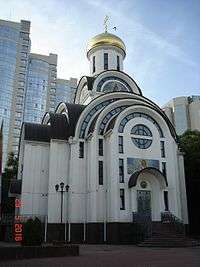Rostov Oblast
Rostov Oblast (Russian: Росто́вская о́бласть, tr. Rostovskaya oblast, IPA: [rɐˈstofskəjə ˈobləsʲtʲ]) is a federal subject of Russia (an oblast), located in the Southern Federal District. The oblast has an area of 100,800 square kilometers (38,900 sq mi) and a population of 4,277,976 (2010 Census),[9] making it the sixth most populous federal subject in Russia. Its administrative center is the city of Rostov-on-Don, which also became the administrative center of the Southern Federal District in 2002.
Rostov Oblast | |
|---|---|
| Ростовская область | |
 Flag 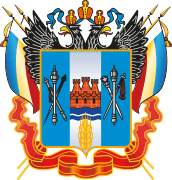 Coat of arms | |
| Anthem: Anthem of Rostov Oblast (The Orthodox Quiet Don)[1] | |
 | |
| Coordinates: 47°52′N 41°11′E | |
| Country | Russia |
| Federal district | Southern[2] |
| Economic region | North Caucasus[3] |
| Established | September 13, 1937[4] |
| Administrative center | Rostov-on-Don[5] |
| Government | |
| • Body | Legislative Assembly |
| • Governor[6] | Vasily Golubev[7] |
| Area | |
| • Total | 100,800 km2 (38,900 sq mi) |
| Area rank | 32nd |
| Population (2010 Census)[9] | |
| • Total | 4,277,976 |
| • Estimate (2018)[10] | 4,220,452 (-1.3%) |
| • Rank | 6th |
| • Density | 42/km2 (110/sq mi) |
| • Urban | 67.2% |
| • Rural | 32.8% |
| Time zone | UTC+3 (MSK |
| ISO 3166 code | RU-ROS |
| License plates | 61, 161, 761 |
| OKTMO ID | 60000000 |
| Official languages | Russian[12] |
| Website | http://www.donland.ru/ |
Geography
Rostov Oblast borders Ukraine and also Volgograd and Voronezh Oblasts in the north, Krasnodar and Stavropol Krais in the south, and the Republic of Kalmykia in the east. The Rostov oblast is located in the Pontic-Caspian steppe.
It is within the Russian Southern Federal District.
Rivers and lakes
The Don River, one of Eurasia's largest rivers, flows through the oblast for part of its course. Lakes cover only 0.4% of the oblast's area.
Administrative divisions
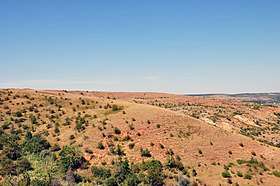
It was formed in 1937 out of the Azov-Black Sea Krai.
Demographics
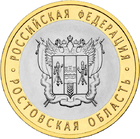
Population: 4,277,976 (2010 Census);[9] 4,404,013 (2002 Census);[13] 4,308,654 (1989 Census).[14]
- Vital statistics for 2012
2009 - 1.38 | 2010 - 1.38 | 2011 - 1.39 | 2012 - 1.51 | 2013 - 1.52 | 2014 - 1.61 | 2015 - 1.63 | 2016 - 1.60(e)
Ethnic groups: Residents identified themselves as belonging to 157 different ethnic groups, including twenty-seven of more than two thousand persons each. The most important ethnicities are[9] the 3,795,607 Russians (90.3%); the 77,802 Ukrainians (1.9%); the 110,727 Armenians (2.6%). Other important groups are the 35,902 Turks (0.9%); 16,493 Belarusians (0.4%)); 13,948 Tatars (0.3%); 17,961 Azerbaijanis (0.4%); 11,449 Chechens (0.3%); 16,657 Romani (0.4%); 11,597 Koreans (0.3%); 8,296 Georgians (0.2%), and 2,040 Assyrians (.05%). There were also 76,498 people (1.8%) belonging to other ethno-cultural groupings. 76,735 people were registered from administrative databases, and could not declare an ethnicity. It is estimated that the proportion of ethnicities in this group is the same as that of the declared group.[17]
Religion
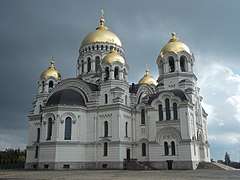
According to a 2012 survey[18] 49.5% of the population of Rostov Oblast adheres to the Russian Orthodox Church, 6% are unaffiliated generic Christians, 1% are either Orthodox Christian believers who don't belong to church or are members of other (non-Russian) Orthodox bodies, 1% are Muslims, and 1% are adherents of the Slavic native faith (Rodnovery) movement. In addition, 26% of the population declares to be "spiritual but not religious", 12% is atheist, and 3.5% follows other religions or did not give an answer to the question.[18]
The Ascension Cathedral is the largest Russian Orthodox church in Novocherkassk, Rostov Oblast, Russia. It used to be one of the largest churches of the Russian Empire and the main church of the Don Host Province.
The five-domed building, which stands 75 meters tall, is a notable example of the Russian Neo-Byzantine architecture. It was erected between 1891 and 1904 on the site of an earlier church. The first church on the site was built to Luigi Rusca's designs. It collapsed in 1846. A replacement church collapsed 17 years later.[20]
Church of the Intercession of the Holy Virgin ― one of the oldest churches in Rostov-on-Don. For a considerable period of time Intercession Church served as the principal church not only for the fortress of St. Dimitry of Rostov, but also for people of local settlements. Since the end of the 18th century Church of Intercession had been considered to be a cathedral. The status changed in 1822, when Church of the Nativity of the Blessed Virgin Mary on the decree of the Holy Synod was declared cathedral.
Attractions



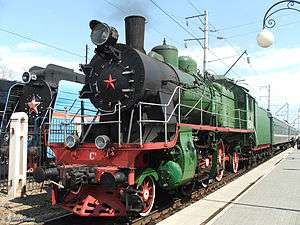

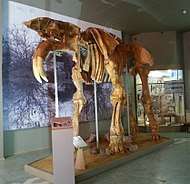
The region is 8057 of objects of archaeological heritage of Federal importance. These include lower-Gnilovskaya a settlement and a necropolis, fragments of the walls of the Genoese fortress of the 14th century, the archaeological Museum-reserve "Tanais", many burial Mounds and necropolises.
Since 2002, in the Rostov region are the country's only racing on tractors "bison-Track-Show". In a unique competition brings together machine operators of agricultural enterprises of Russia and abroad. In the past the race on tractors have become a real sports holiday of workers of agriculture.
Theatres
- Rostov academic drama theatre named after Maxim Gorky.
- Rostov State Musical Theater . The theater opened in September 1999, and is the successor to the 1919 Rostov Musical Comedy Theater, one of the best operetta theaters in the Soviet Union.
The theater has two stages as well as a music and entertainment center, and hosts about 300 performances and concerts annually, as well as various forums and festivals. Its repertoire encompasses both musical traditions, as well as experiments in the field of contemporary art.
- Rostov state puppet theatre.
- Rostov regional academic youth theatre (former Rostov theatre for young spectators).
- Taganrog Theatre. The Taganrog Theater was established in 1827 by governor Alexander Dunaev. The theater was subsidized by the Taganrog's City Council since 1828, and its first director was Alexander Gor. The first group of Russian drama artists was directed by Perovsky and toured around the region, giving performances in Rostov on Don, Novocherkassk, Bahmut. The repertoire consisted mainly of dramas, melodramas and vaudevilles. In 1874, the Taganrog Municipality acquired the theater building by the purchase of its stocks.
- Don theatre of drama and Comedy V. F. Komissarzhevskaya (the Cossack drama theatre) Novocherkassk.
- Shakhty drama theatre, Shakhty.
- Novoshakhtinskiy drama theatre, Novoshakhtinsk.
Museums
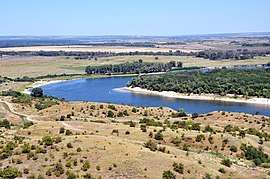
In Rostov-on-Don
- Rostov Regional Museum of Local History.
- Rostov Regional Museum of Fine Arts.
- Museum of Contemporary Art at Dmitrovskaya.
- Museum of Russian-Armenian Friendship.
- Museum of North Caucasus Railway. The first museum of history of North Caucasus Railway opened on 4 November 1960 in a Community Center of railwaymen at Rostov-Glavny station. Permanent exposition includes: information boards about famous North Caucasus railwaymen, model trains on a scale 1:15, uniform, cases, panoramas, implements of various times. The exhibition covers the period from emergence of rail transport in the region up to the present moment. The various collections from the Russian Civil War and the Great Patriotic War, now exceed 12,000 objects in the main fund.[21]
- Center for Contemporary Art "Tobacco Factory".
In other cities of the region
- Aksai Military History Museum, Aksay.
- Archaeological museum-reserve "Tanais", Nedvigovka.
- Azov History, Archaeology and Paleontology Museum-Reserve, Azov. The bulk of the museum is located in the three-story building erected in 1892 which belonged to the former town council, there are 22 rooms. The symbol of the museum is the skeleton of a Trogontherium mammoth that existed 800-600 thousand years ago in the interglacial period. This is the world’s unique skeleton with the whole skull. The museum's areas: permanent exhibitions - 2852 m², temporary exhibitions - 580 m², storage facilities - 1896 m², park (open air) - 7.13 hectares.
- Bataysk Museum of History, Bataysk.
- Gukovo Museum of Mining Work, Gukovo.
- House-Museum of S. Budyonny, Stan. Budennovskaya.
- Novocherkassk Museum of the History of the Don Cossacks, Novocherkassk.
- Razdorsk Ethnographic Museum-Reserve, the camp. Razdorskaya.
- Salsk Art Museum named after People's Artist VK Nechitailo, Salsk.
- Shakhty Museum of Local History, Shakhty.
- Taganrog military museum, Taganrog. The start of museum exhibition creation refers to May 9, 2004, when the club Auto-Retro Taganrog was founded. Subsequently, several vehicle units were purchased and repaired. In 2008, club activity concept got military direction. On May 6, 2010, permanent exhibition consisting of several thousands of exhibits was opened. In July 2012, the name Taganrog military museum got official status.
- The State Museum-Reserve of MA Sholokhov, St. Veshenskaya.
- Volgodonsk Art Museum, Volgodonsk.
- Volgodonsk Ecological and Historical Museum, Volgodonsk.
Economy

Major industries of Rostov Oblast are agriculture, agricultural industry, food processing, heavy industry, coal and automobile manufacture.[22]
The largest companies in the region include Novoshakhtinsk Petrochemical Plant, Gloria Jeans Corp., Rostvertol, Oil-extracting factory "Yug Rusi", North Caucasian Railway.[23]
Culture
References
- Law #30-ZS
- Президент Российской Федерации. Указ №849 от 13 мая 2000 г. «О полномочном представителе Президента Российской Федерации в федеральном округе». Вступил в силу 13 мая 2000 г. Опубликован: "Собрание законодательства РФ", No. 20, ст. 2112, 15 мая 2000 г. (President of the Russian Federation. Decree #849 of May 13, 2000 On the Plenipotentiary Representative of the President of the Russian Federation in a Federal District. Effective as of May 13, 2000.).
- Госстандарт Российской Федерации. №ОК 024-95 27 декабря 1995 г. «Общероссийский классификатор экономических регионов. 2. Экономические районы», в ред. Изменения №5/2001 ОКЭР. (Gosstandart of the Russian Federation. #OK 024-95 December 27, 1995 Russian Classification of Economic Regions. 2. Economic Regions, as amended by the Amendment #5/2001 OKER. ).
- Charter of Rostov Oblast, Article 13
- Charter of Rostov Oblast, Article 14
- Charter of Rostov Oblast, Article 27
- Official website of Rostov Oblast. Vasily Yuryevich Golubev, Governor of Rostov Oblast (in Russian)
- Федеральная служба государственной статистики (Federal State Statistics Service) (May 21, 2004). "Территория, число районов, населённых пунктов и сельских администраций по субъектам Российской Федерации (Territory, Number of Districts, Inhabited Localities, and Rural Administration by Federal Subjects of the Russian Federation)". Всероссийская перепись населения 2002 года (All-Russia Population Census of 2002) (in Russian). Federal State Statistics Service. Retrieved November 1, 2011.
- Russian Federal State Statistics Service (2011). "Всероссийская перепись населения 2010 года. Том 1" [2010 All-Russian Population Census, vol. 1]. Всероссийская перепись населения 2010 года [2010 All-Russia Population Census] (in Russian). Federal State Statistics Service.
- "26. Численность постоянного населения Российской Федерации по муниципальным образованиям на 1 января 2018 года". Federal State Statistics Service. Retrieved January 23, 2019.
- "Об исчислении времени". Официальный интернет-портал правовой информации (in Russian). June 3, 2011. Retrieved January 19, 2019.
- Official throughout the Russian Federation according to Article 68.1 of the Constitution of Russia.
- Russian Federal State Statistics Service (May 21, 2004). "Численность населения России, субъектов Российской Федерации в составе федеральных округов, районов, городских поселений, сельских населённых пунктов – районных центров и сельских населённых пунктов с населением 3 тысячи и более человек" [Population of Russia, Its Federal Districts, Federal Subjects, Districts, Urban Localities, Rural Localities—Administrative Centers, and Rural Localities with Population of Over 3,000] (XLS). Всероссийская перепись населения 2002 года [All-Russia Population Census of 2002] (in Russian).
- "Всесоюзная перепись населения 1989 г. Численность наличного населения союзных и автономных республик, автономных областей и округов, краёв, областей, районов, городских поселений и сёл-райцентров" [All Union Population Census of 1989: Present Population of Union and Autonomous Republics, Autonomous Oblasts and Okrugs, Krais, Oblasts, Districts, Urban Settlements, and Villages Serving as District Administrative Centers]. Всесоюзная перепись населения 1989 года [All-Union Population Census of 1989] (in Russian). Институт демографии Национального исследовательского университета: Высшая школа экономики [Institute of Demography at the National Research University: Higher School of Economics]. 1989 – via Demoscope Weekly.
- "Естественное движение населения в разрезе субъектов Российской Федерации". www.gks.ru.
- "Каталог публикаций::Федеральная служба государственной статистики". www.gks.ru.
- "ВПН-2010". www.perepis-2010.ru.
- "Arena: Atlas of Religions and Nationalities in Russia". Sreda, 2012.
- 2012 Arena Atlas Religion Maps. "Ogonek", № 34 (5243), 27/08/2012. Retrieved 21/04/2017. Archived.
- "История - Официальный сайт Ростовской и Новочеркасской епархии". rostoveparhia.ru.
- Музей истории Северо-Кавказской железной дороги (in Russian). Localway. Retrieved August 12, 2017.
- "Industry of the region". invest-don.com/en/promyshlennost_regiona.
- "Rostov region Industries". investinregions.ru. Retrieved November 7, 2018.
Sources
- Законодательное Собрание Ростовской области. Областной закон №19-ЗС от 29 мая 1996 г. «Устав Ростовской области», в ред. Областного закона №442-ЗС от 23 ноября 2015 г. «О поправках к Уставу Ростовской области». Вступил в силу 6 июня 1996 г. Опубликован: "Наше время", №98–99, 6 июня 1996 г. (Legislative Assembly of Rostov Oblast. Oblast Law #19-ZS of May 29, 1996 Charter of Rostov Oblast, as amended by the Oblast Law #442-ZS of November 23, 2015 On the Amendments to the Charter of Rostov Oblast. Effective as of June 6, 1996.).
- Глава Администрации Ростовской области. Областной Закон №30-ЗС от 10 октября 1996 г. «О гимне Ростовской области». Вступил в силу с момента опубликования (31 октября 1996 г.). Опубликован: "Наше время", №196, 31 октября 1996 г. (Head of the Administration of Rostov Oblast. Oblast Law #30-ZS of October 10, 1996 On the Anthem of Rostov Oblast. Effective as of the moment of publication (October 31, 1996).).
External links
| Wikimedia Commons has media related to Rostov Oblast. |
- Official website of Rostov Oblast (in Russian)
- Russian South. News and events of Rostov Oblast
- Official Tourism Portal of Rostov Oblast
- Official Tourism Portal of Rostov Oblast (in Russian)
- Central Eurasian Information Resource: Images of Rostov Oblast - University of Washington Digital Collection
